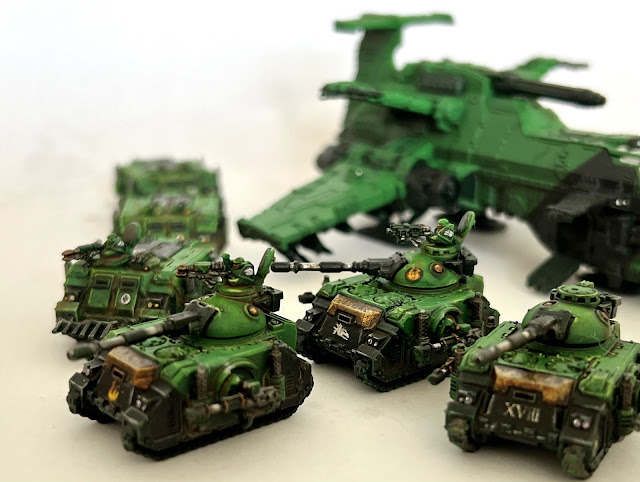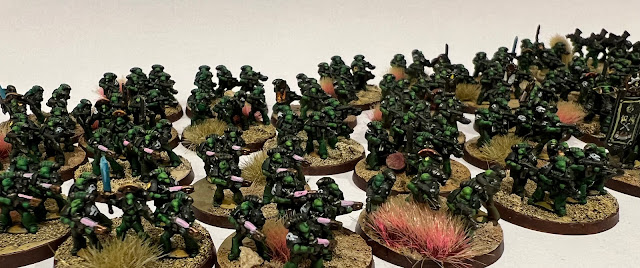+ Common Core Concepts +
Friday, April 19
+ inload: Third Company returns to base +
Wednesday, April 17
+ inload: Building Epic Land Raiders +
+ Notes on the Epic Land Raiders +
+ A box of the grandly-titled 'Legions Astartes Land Raider Proteus Explorator Squadron' arrived safely at my door yesterday, and I couldn't resist getting building. These are fun little tanks, but as I found a few little quirks in the build, I thought I'd flag them up to help forewarn other intrepid Enginseers. ++ SCRAPSHUNTERRORABORT +
 |
| + You can ignore steps 2a and 2b entirely. + |
+ Once you're aware of this, the rest of the build proceeds as directed, except that you need to deduct two from each reference in the instructions to get the correct component number. Below is a marked-up copy of the final steps, with the correct numbers in red. +
+++
+ On the bright side +
+ The mistake is undoubtedly a minor annoyance when building, but shouldn't overshadow what is a lovely litle kit. The components are wonderfully engineered and go together well; the two-part top being a particularly interesting construction that literally locks together in a way I've not seen before from GW. +
+ Leaving the mistake in the instructions aside, these tiny Land Raiders are a treat to put together, with far fewer fiddly bits than the Rhinos and Predators, whose separate exhausts are a chore. The lascannon sponsons are also arranged on the sprue better, with the joins avoiding the most delicate parts, helping to avoid putting strain on the gun barrels when removing them. The only other thing that I would flag up is component 3 on the sprue (the odd radiator thing that sits at the front of the chassis), as I nearly bent the side parts in removing it from the sprue. +
+++
 |
| + The completed model, lascannons and exhausts drilled out and commander perched |
+ It's a pure guess, but I presume that the change must have happened quite late on in the process, and that the drive wheel components were replaced on the sprue with extra hatches and gunners, because the silver lining of the error seems to be that you get an absolute pile of crew members and hatches. +
+ Every sprue contains three tanks, but four identical gunners plus a commander. Unlike the Predator and Rhino sprues, which have a single pintle-mounted gun (a multimelta and heavy bolter for each kit respectively), each Land Raider sprue gives you three pintle-mounted heavy bolters plus a single multimelta. While this is more than you can use for the Land Raiders themselves, these extra crew members and guns are useful both in game terms (as Rhinos, oddly, can take in-game multi-meltas), and for visual variety. +
+ If you're picking up a box alongside other kits, you'll end up with some useful spares, so bear that in mind. +
+++
+ The Salamanders are having a tough time of it on Armageddon, so doubtless they'll appreciate the arrival of some heavy armour! Come read more about the ongoing campaign through the noosphericexloadlink below, and remember that all you need do to get involved is to use the tag #ashesofarmageddon +
+ THE ASHES OF ARMAGEDDON: HADES DEFIANT +
Thursday, April 4
+ inload: Notes on finished Epic Salamanders +
+ Battlefield ready +
 |
| + Permission to make planetfall requested. + |
+ Phew – over the finish line with a little grace to spare. There are some further refinements that could be done, but I think my Salamanders army is ready to spend the weekend searching for Archaeotech on Nabed-Palae, the Forge-throne of Legio Maximal. +
+++
+ Markings and details +
+ As well as polish off the tanks and transport, I've finished the Thunderhawk and big guns – and spent a few minutes adding some banner detail to this Command stand, too. +
+ Being themed around Armageddon, I took a little inspiration from the boxed game cover [+vizref: below+] and used the shoulder pad on this marine as a prompt for the banner. +
 |
| + Detail from the Battle for Armageddon box set front + |
+ Thunderhawk inbound +
- The sky is dark at the top and gets lighter towards the horizon, while the land is darkest at the horizon and lightest in the foreground.
- The glass is at different angles, so (unless you've modelled it in a very steep dive!) the front panes won't be reflecting the horizon halfway up the glass, but rather near the bottom. Likewise the top panes of glass won't be reflecting the ground at all, but instead show the darkest tone of the sky across nearly the whole panel.
Tuesday, April 2
+ inload: Tips for painting Epic-scale models for Legions Imperialis +
+ Lesson from painting Epic models +
+ Detailing Epic models +
+ Theoretical +
 |
| Even in death I still serve (as an example of stylistic changes in sculpting). |
- Lost light Small models reflect less light – so need to be treated differently.
- The crowd effect As a mass, Epic models show less individuality than their 40k equivalents. Differences clear at 40k scale might be lost entirely for Epic models at table distance.
- Space for variation Mass models are more visually coherent, so variations in painting and finishing offer opportunities for personalisation that won't 'read' at typical distances.
+ Practical +
 |
| Highlighting and shading on the Rhino add visual texture and detail that make the surfaces look more distant than the flatter planes of the base-coated Thunderhawk. |
Of note is that this might not be the style you want – loss of detail and reduction in saturation and contrast are real world signifier of distance, thanks to aerial perspective. As a result, you might want to simulate this for a particular effect – in which case you need to steer clear of edge highlighting and surface modelling.
+ The crowd effect +
+ What do I mean that Epic-scale models show less individuality than 40k-scale models? Simply that at typical working distances, Epic-scale models are far less visually distinct from one another, which you should be aware of. The combination of there being more of them, and each individual figure or tank being smaller (and thus giving less space for conversion work than their 40k equivalents) means that they'll tend to blend into one another more. + | |
|
 |
| + Included here are Tactical stands, Plasma support stands, Missile Launcher Devastators, Terminators and Command stands. + |
+ Space for variation and personalisation +
+ Decide before you begin what you want to simplify; and whether you want to include such detail at all. There is no shame at all in a simple approach – as we've seen above, you can spend a great deal of effort in gilding the lily, and creating detail that will be seen only vanishingly rarely, even on the display shelf. +
+ The Corsair Gambit +
- One additional stand of Terminators
- Two stands of Assault Marines
- Support: Four Dreadnoughts
- Support: Four Dreadnoughts
- Battle Tank: Three Predators
- Transport: Eight Rhinos
- Air Support: Thunderhawk Gunship
- Bastion: Four Tarantulas
- Battle Tank: Six Predators
- Transport: Five Rhinos.
- Transport: Five Rhinos.
- Three objectives






















